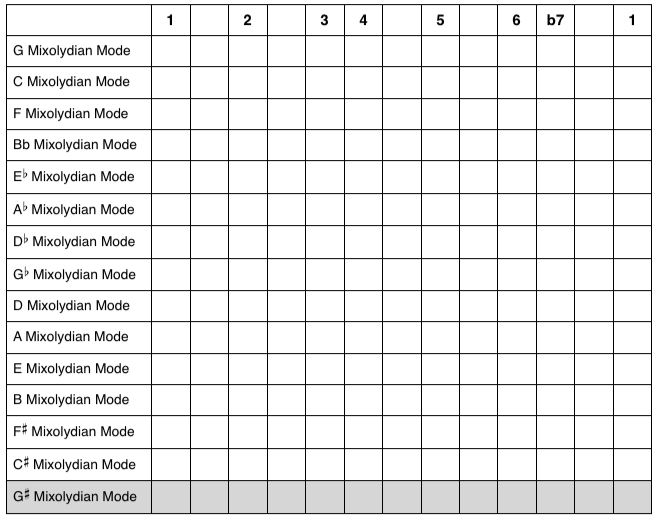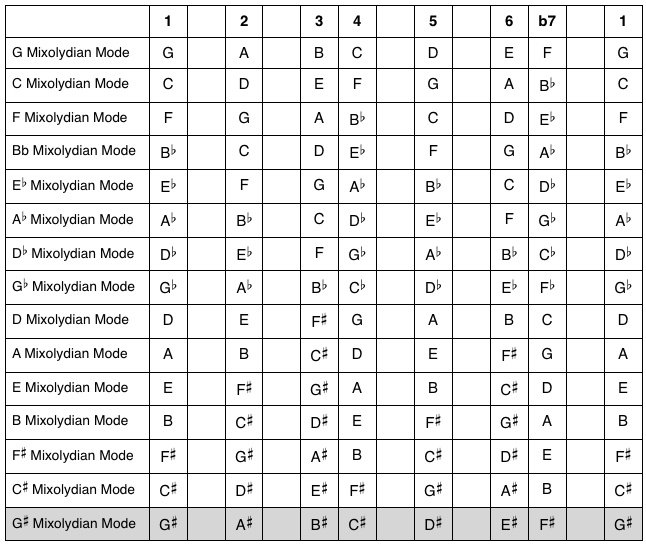Welcome back to another fun-filled lesson on the major scale modes! In this guitar lesson, we’re going to start looking at the mixolydian mode, which is an incredibly useful scale that has a warm and bluesy sound to it.
I’ll be giving you a practical application exercise later on, but let’s get started now by looking at some of the theory related to the mixolydian mode…
Musical Spelling
The musical spelling of the mixolydian mode is almost identical to that of the major scale. In fact, the only difference is that it has a b7. (In case you don’t know, this scale degree number is pronounced “Flat Seven”).
![]()
Although there is only one small difference between the mixolydian mode and the major scale, in my opinion it makes a huge difference to the sound and personality of the scale. I think that the b7 has a much warmer and rounded sound, compared to the 7 of the major scale. (Which, to my ears, has a brighter and sharper sound).
How To Use The Musical Spelling
Let’s now take a look at an example of how to use the musical spelling of the mixolydian mode…
Example: A Mixolydian Mode
In this example we’ll be working out the notes of the A Mixolydian mode. To do this, we’ll need to follow these steps…
Step 1: Write down the notes of the A major scale. This will give us these notes…

Step 2: As you know from earlier on in the lesson, the mixolydian mode has a b7. This means, in this example, we need to take the seventh note of the A major scale, and lower it by one half-step.
Doing this gives us the notes of the A Mixolydian mode…

Demonstration Video
Here’s a short video that shows you how to turn a major scale fingering into a mixolydian mode fingering. I’ve also included a short demonstration where I improvise a solo using the A Mixolydian mode.
Now It’s Your Turn
While reading about this music theory can be somewhat helpful, I think that you’ll learn much more by working out the notes of some mixolydian modes yourself. So please make sure that you take the time to fill out the blank table below. I recommend doing only a few keys each day, rather than doing them all at once. This approach will make the task more enjoyable to do, and the daily repetition will help you learn the theory more effectively.
You probably notice that I’ve highlighted the last key of the table. The reason why I’ve done this is that it’s not possible to work out G# Mixolydian by using the two step method we covered earlier. (This is because there is no G# major scale). To work this key out, your best bet is to raise all the notes of the G Mixolydian mode by one half-step.
Please make sure that you fill out the table before reading any further. I’ll be giving you the answers later on, and I don’t want you to cheat by reading them before you’ve filled out the table. 🙂
All done? Great work! You can see if your answers are right by looking at the completed table below…
The Answers
Here are the answers to the table you’ve just filled out. If you made any mistakes, it’s important that you work out where you went wrong.

Putting This Music Theory Into Practice
Let’s now look at a fun way of applying this music theory. To do this, you’ll be using the mixolydian mode to solo over a backing track that I’ve created for this lesson. To get started with this application exercise, please follow these steps…
- Memorize the single string scale fingering for the A Mixolydian mode shown below. Don’t just memorize the fret locations. It’s really important that you also memorize the note names and the scale degree numbers. (Doing this will ensure that you understand the musical meaning of the scale fingering that you’re learning).

- Improvise over the backing track using the scale fingering that you’ve just memorized. Listen very closely to the sound of all the notes you play, and make sure that you play the b7 lots of times to learn how this specific scale degree sounds.
- After you’ve finished improvising over the backing track, write down your description of how you think the mixolydian mode sounds.
A Few Last Words
I hope you enjoyed this lesson, and had a lot of fun with jamming over the backing track. We’ll be delving into the mixolydian mode in more detail in future lessons. But for now, just focus on getting to know its sound.
Have fun!
Return To: Guitar Music Theory Lessons